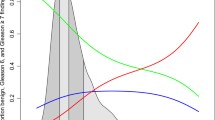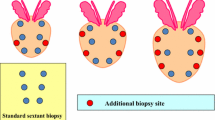Abstract
Objectives
To evaluate the diagnostic value of 12 core biopsy versus sextant biopsy at different prostatic-specific antigen densities (PSAD).
Methods
We retrospectively analyzed the records of 1,463 patients who underwent transrectal ultrasound-guided prostate biopsies at our institution. 995 patients underwent 12 core biopsy and 468 sextant biopsy of the prostate. The cancer detection rates achieved by these two methods were analyzed at different PSAD levels.
Results
All patients were stratified into 5 groups according to PSAD level; group A: PSAD < 0.1 (n = 290), group B: 0.1 ≤ PSAD < 0.2 (n = 572), group C: 0.2 ≤ PSAD < 0.3 (n = 248), group D: 0.3 ≤ PSAD < 0.4 (n = 122), and group E: PSAD ≥ 0.4 (n = 231). In group B, 12 core biopsy had a higher detection rate than 6 core biopsy (P = 0.017).
Conclusions
These results demonstrate 12 core biopsy is better able to detect cancer than 6 core biopsy in patients with a PSAD in the range 0.1–0.2, which suggests that PSAD be considered when deciding on the number of prostate biopsy cores required.

Similar content being viewed by others
References
Hodge KK, McNeal JE, Terris MK, Stamey TA (1989) Random systematic versus directed ultrasound guided transrectal core biopsies of the prostate. J Urol 142:71–74
Svetec D, McCabe K, Peretsman S, Klein E, Levin H, Optenberg S et al (1998) Prostate rebiopsy is a poor surrogate of treatment efficacy in localized prostate cancer. J Urol 159:1606–1608
Levine MA, Ittman M, Melamed J, Lepor H (1998) Two consecutive sets of transrectal ultrasound guided sextant biopsies of the prostate for the detection of prostate cancer. J Urol 159:471–475
Norberg M, Egevad L, Holmberg L, Sparen P, Norlen BJ, Busch C (1997) The sextant protocol for ultrasound-guided core biopsies of the prostate underestimates the presence of cancer. Urology 50:562–566
Naughton CK, Smith DS, Humphrey PA, Catalona WJ, Keetch DW (1998) Clinical and pathologic tumor characteristics of prostate cancer as a function of the number of biopsy cores: a retrospective study. Urology 52:808–813
Eskew LA, Bare RL, McCullough DL (1997) Systematic 5 region prostate biopsy is superior to sextant method for diagnosing carcinoma of the prostate. J Urol 157:199–202
Stewart CS, Leibovich BC, Weaver AL, Lieber MM (2001) Prostate cancer diagnosis using a saturation needle biopsy technique after previous negative sextant biopsies. J Urol 166:86–91
Babaian RJ, Toi A, Kamoi K, Troncoso P, Sweet J, Evans R et al (2000) A comparative analysis of sextant and an extended 11-core multisite directed biopsy strategy. J Urol 163:152–157
Presti JC Jr, Chang JJ, Bhargava V, Shinohara K (2000) The optimal systematic prostate biopsy scheme should include 8 rather than 6 biopsies: results of a prospective clinical trial. J Urol 163:163–166
Ravery V, Goldblatt L, Royer B, Blanc E, Toublanc M, Boccon-Gibod L (2000) Extensive biopsy protocol improves the detection rate of prostate cancer. J Urol 164:393–396
Keetch DW, Catalona WJ, Smith DS (1994) Serial prostatic biopsies in men with persistently elevated serum prostate specific antigen values. J Urol 151:1571–1574
Chan TY, Chan DY, Stutzman KL, Epstein JI (2001) Does increased needle biopsy sampling of the prostate detect a higher number of potentially insignificant tumors? J Urol 166:2181–2184
Gore JL, Shariat SF, Miles BJ, Kadmon D, Jiang N, Wheeler TM et al (2001) Optimal combinations of systematic sextant and laterally directed biopsies for the detection of prostate cancer. J Urol 165:1554–1559
Naughton CK, Miller DC, Mager DE, Ornstein DK, Catalona WJ (2000) A prospective randomized trial comparing 6 versus 12 prostate biopsy cores: impact on cancer detection. J Urol 164:388–392
Ung JO, San Francisco IF, Regan MM, DeWolf WC, Olumi AF (2003) The relationship of prostate gland volume to extended needle biopsy on prostate cancer detection. J Urol 169:130–135
Xia SJ, Xu XX, Teng JB, Xu CX, Tang XD (2002) Characteristic pattern of human prostatic growth with age. Asian J Androl 4:269–271
Ellis WJ, Brawer MK (1995) Repeat prostate needle biopsy: who needs it? J Urol 153:1496–1498
Roehrborn CG, Pickens GJ, Sanders JS (1996) Diagnostic yield of repeated transrectal ultrasound-guided biopsies stratified by specific histopathologic diagnoses and prostate specific antigen levels. Urology 47:347–352
Chen ME, Troncoso P, Johnston DA, Tang K, Babaian RJ (1997) Optimization of prostate biopsy strategy using computer based analysis. J Urol 158:2168–2175
Presti JC Jr, O’Dowd GJ, Miller MC, Mattu R, Veltri RW (2003) Extended peripheral zone biopsy schemes increase cancer detection rates and minimize variance in prostate specific antigen and age related cancer rates: results of a community multi-practice study. J Urol 169:125–129
Eskicorapci SY, Baydar DE, Akbal C, Sofikerim M, Gunay M, Ekici S et al (2004) An extended 10-core transrectal ultrasonography guided prostate biopsy protocol improves the detection of prostate cancer. Eur Urol 45:444–448
Singh H, Canto EI, Shariat SF, Kadmon D, Miles BJ, Wheeler TM et al (2004) Improved detection of clinically significant, curable prostate cancer with systematic 12-core biopsy. J Urol 171:1089–1092
Fink KG, Hutarew G, Pytel A, Esterbauer B, Jungwirth A, Dietze O et al (2003) One 10-core prostate biopsy is superior to two sets of sextant prostate biopsies. BJU Int 92:385–388
Philip J, Ragavan N, Desouza J, Foster CS, Javle P (2004) Effect of peripheral biopsies in maximising early prostate cancer detection in 8-, 10- or 12-core biopsy regimens. BJU Int 93:1218–1220
Durkan GC, Sheikh N, Johnson P, Hildreth AJ, Greene DR (2002) Improving prostate cancer detection with an extended-core transrectal ultrasonography-guided prostate biopsy protocol. BJU Int 89:33–39
Shin HR, Won YJ, Jung KW, Kong HJ, Yim SH, Lee JK et al (2005) Nationwide cancer incidence in Korea, 1999–2001; first resulting using the National Cancer Incidence Database. Cancer Res Treat 37:325–331
Korea National Statistical Office (2005) The cause of death statistics, 1983–2003, Korea
Sim HG, Cheng CW (2005) Changing demography of prostate cancer in Asia. Eur J Cancer 41:834–845
Lee SE, Kwak C, Park MS, Lee CH, Kang W, Oh SJ (2000) Ethnic differences in the age-related distribution of serum prostate-specific antigen values: a study in a healthy Korean male population. Urology 56:1007–1010
Choi YD, Kang DR, Nam CM, Kim YS, Cho SY, Kim SJ et al (2007) Age-specific prostate-specific antigen reference ranges in korean men. Urology 70:1113–1116
Oesterling JE, Kumamoto Y, Tsukamoto T et al (1995) Serum PSA in a community-based population of healthy Japanese men: lower values than for similarly aged White men. Br J Urol 75:347–353
Kuwahara M, Tochigi T, Kawamura S, Ogata Y, Xu N, Wang H et al (2004) Mass screening for prostate cancer: a comparative study in Natori, Japan and Changchun, China. Urology 61:137–141
He D, Wang M, Chen X, Gao Z, He H, Zhau HE et al (2004) Ethnic differences in distribution of serum prostate-specific antigen: a study in a healthy Chinese male population. Urology 63:722–726
Egawa S, Suyama K, Matsumoto K et al (1998) Improved predictability of extracapsular extension and seminal vesicle involvement based on clinical and biopsy findings in prostate cancer in Japanese men. Urology 52:433–440
Oesterling JE, Jacobsen SJ, Chute CG et al (1993) Serum prostate-specific antigen in a community-based population of healthy men. Establishment of age-specific reference ranges. JAMA 270:860–864
Oesterling JE, Kumamoto Y, Tsukamoto T et al (1995) Serum prostate-specific antigen in a community-based population of healthy Japanese men: lower values than for similarly aged white men. Br J Urol 75:347–353
Ku JH (2006) Race-specific reference ranges of serum prostate-specific antigen levels in countries with a low incidence of prostate cancer. BJU Int 97:69–72
Kim JW, Lee HY, Hong SJ, Chung BH (2004) Can a 12 core prostate biopsy increase the detection rate of prostate cancer versus 6 core? a prospective randomized study in Korea. Yonsei Med J 45:671–675
Yang WJ, Lee DH, Chung BH, Cho JS, Choi YD, Kim SJ et al (2006) Detection rate of prostate cancer on biopsy according to serum prostate-specific antigen in Korean men: a multicenter study. Urology 67:333–336
Seo HK, Chung MK, Ryu SB, Lee KH, the Korean Urological Oncologic Society Prostate Cancer Study Group (2007) Detection rate of prostate cancer according to prostate-specific antigen and digital rectal examination in Korean men: a nationwide multicenter study. Urology 70:1109–1112
Egawa S, Matsumoto K, Yoshida K, Iwamura M, Kuwao S, Koshiba K (1998) Results of transrectal ultrasound-guided biopsies and clinical significance of Japanese prostate cancer. Jpn J Clin Oncol 28:666–672
Song C, Ro JY, Lee MS, Hong SJ, Chung BH, Choi HY et al (2006) Prostate cancer in Korean men exhibits poor differentiation and is adversely related to prognosis after radical prostatectomy. Urology 68:820–4
HongSK, Yu JH, Han BK, Chang IH, Jeong SJ, Byun SS et al (2007) Association of prostate size and tumor grade in Korean men with clinically localized prostate cancer. Urology 70:91–95
Conflict of interest statement
There is no conflict of interest.
Author information
Authors and Affiliations
Corresponding author
Rights and permissions
About this article
Cite this article
Jeong, H., Jeong, B.C., Kwak, C. et al. A comparison of prostate cancer detection rates by 12 or 6 core biopsy at different prostate-specific antigen densities in Korean men. World J Urol 26, 395–400 (2008). https://doi.org/10.1007/s00345-008-0264-1
Received:
Accepted:
Published:
Issue Date:
DOI: https://doi.org/10.1007/s00345-008-0264-1




